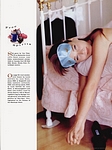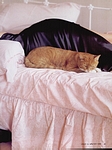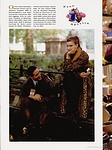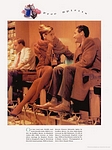L.A TimesFashion 88
The Style Broker, Omar the Agent Says Goodbye to the Ken Doll Image and Hello to a New Realism in Male Modeling
December 02, 1988|
JEANNINE STEINOmar the modeling agent doesn't like to call his models models: "I want to have an agency of real people, not models. They are real, everyday people with great style."
Omar the modeling agent refuses to scout for models: "It has to just happen. I should just walk in the street and bump into a guy and he'll say something to me and I'll say something to him and my heart opens up to this human being and I'll see that he has great style and I'll say, 'Wow, let me give you a shot.' "
Omar the modeling agent doesn't want to be called a modeling agent: "I'm nobody's agent, I'm their friend. I don't like that agent-model relationship. The day you treat me as an agent, that's the day I don't want to represent you anymore."
 Eric Knorpp
Eric Knorpp, 1988
It's an unorthodox formula but it has worked to
Omar's advantage. His models are regularly seen in
GQ and
L'Uomo Vogue, shot by such superstar photographers as
Herb Ritts and
Matthew Rolston.But then,
Omar himself is a little unorthodox. The 31-year-old head of
Omar's Men modeling agency has taken his ability to find photogenic, but offbeat-looking men and turned it into a business that in its first year grossed $1 million. His dislike for the "Ken doll" look has paid off. Magazines and ad agencies are bypassing gorgeous hunks in favor of guys with big noses, long hair and impish grins.
"I thought this town needed to expand as far as visuals," he explains as he puffs on the first of many cigarettes. "Enough of this Barbie-and-Ken thing. Please understand: People are beautiful in all races, all colors, all heights. I'm trying to break through all those barriers. There is nothing wrong with having that all-American look. Me, personally, I like to market all types."
His roster includes Turkish, Cambodian, Brazilian and Filipino men as well as some born in the United States. They may not look like typical male models, but they do have one crucial element: an innate sense of style.
"I'm trying to make the modeling industry like the film industry, where everybody gets a shot at it," he says, adding, " 'cause nowadays all you need is a little bit of style and you become a model."
He makes it sound easy. It may be now, but wasn't always so. In the beginning it was "very tough" to persuade clients to use anything other than traditional models from an agent they had never heard of.
"This is the way I approach it," he says, "which is kind of my secret--and I don't want to tell my secrets to the world-- but --my view is, 'I'm going to give you an image for your company.' Not a model, an image. An image that could sell that product. So images don't have to be all the same.
"They'll say, 'We always use blond, blue-eyed guys.' And I say, 'Well, why don't you try something else and see if your marketing goes up or down? Why don't you give me a shot at that?' It has worked, so far.
"Look at this guy," he says, gesturing to a lanky model with long, wavy hair, a prominent nose and a 3-day growth of beard. "He's not the best-looking guy in the world but he does make money as a model. Why? He has such great style, great character. He knows how to speak, he knows how to present himself to a client. That's important."
 David Charles
David Charles, 1988
Martha Maristany, model editor at
GQ in New York, agrees. "There was just a need in magazines and advertising for more real people that our readers could relate to. We want people to look at the magazine and say, 'I could buy that suit and look like that.' Yes, you want the fantasy, but you want the realism, too.
"Photographers are happy to work with real-looking people, too," she adds. "They have a better look about themselves, they're more casual, and they move better. I think they even wear the clothes better."
Says photographer
Rolston: "My point of view on models is that just being beautiful isn't enough. There has to be a memorable quality to the person. I think he's got a lot of those kinds of guys who really project a lot of feeling."
Michael Lee, art director for fashion for The Broadway, says of
Omar's models: "His guys understand what a garment does. When we shoot, everything is pinned and taped, so the model has to have an understanding of how to show off that garment to is best advantage. And if I'm in a bind, I can describe the kind of outfit I'm shooting, and I have complete trust that he'll send me somebody he knows I'll like."
His success is owed to more than a keen eye for faces. When Omar pitches his models, he pitches a piece of himself, too. After all, half of Omar's men is Omar.
He makes an impression even on the phone, with his deep, gravelly voice that has an accent of indeterminable origin.
"Hold all my calls, baby, please?" he asks his assistant, but she tells him it's Todd on the phone. He picks up. "Todd? Toddie? Hey, baby!" he says, launching into auto-pilot schmooze.
In 3-D, Omar is a 6-foot-something live wire with impossibly long legs and straight hair slicked back, a collection of bracelets on his wrist and a chunky silver ring that says "JAH" (for Haile Selassie, the late emperor of Ethiopia.) "My mother is Ethiopian," he explains, "So I carry Jah with me since I was 15 years old."
 Djimon Hounsou, 1989
Djimon Hounsou, 1989His father, a Spaniard, owns travel agencies worldwide, explaining Omar's ability to speak seven languages, his claim to an education in 40 different schools and his distaste for labels.
His name is
Omar Alberto de la Rossa but his business cards read simply
Omar Alberto. "I want people to know I'm Spanish 'cause Omar sounds Arab," he explains. "I'm don't want people to think I'm an Arab. And I don't want people to think I'm religious. I'm not.
"As a matter of fact I'm Jewish Ethiopian. My mother is Jewish. But I don't want them to say, 'He's Jewish,' or 'He's Catholic.' I just love everybody."
He started modeling after being discovered by a scout. He hooked up with Elite models in New York and was sent to Europe because agents told him his look wasn't "black enough," but more European.
While living in Milan and doing mostly runway and showroom work, he spent weekends in New York (his father's connections with the airlines helped) at the legendary disco palace Studio 54. There, he says, he got his fashion education.
"I'd go only to be seen and see the beautiful people," he says. "To be able to talk with
Andy Warhol or
Diana Vreeland, the empress of fashion, people like that. To me they were geniuses of the industry. It's a very visual business. If you're seen with a jerk, you are a jerk. If you're seen with a celebrity, people want to know who you are."
He segued from modeling into working as an agent in New York in a small firm. There, he befriended
Paul Fisher, and when they decided to go West they headed for Los Angeles to
EastWest models.
Omar represented men;
Paul, women.
After 1 1/2 years they left.
Paul went first and set up his own firm, It Model Management.
Omar quit months later, not knowing what he would do next. But without his knowing it,
Fisher already had set up a phone line for Omar.
 Todd Gordon
Todd Gordon, 1988
"Yes, I had the phone installed, and yes, I had it taken out in his name,"
Fisher admits. "But I knew that if we were set up, and all the models were able to be paid, (if) we had the talent agency license and (if) we were completely legitimate, then it would just be a matter of time. Nothing could keep us apart. We belong together.
"I wouldn't want to be in the business without Omar. I'd probably go crazy, to be honest with you."
Fisher, 28, is as inwardly intense as
Omar is gregarious. He has dark circles under his eyes and sports a few days' beard growth that makes him look like a younger
Mickey Rourke. Of course, he chain smokes. He considers his "girls" his friends, too, and says there isn't anything he wouldn't do for them. He is fiercely protective.
"If I find out that a photographer has taken a picture of one of my girls topless," he says calmly, "I'll break his hands. I'll break his hands."
They have polished the good-model-agent/bad-model-agent routine.
Omar knows he can be a pushover, and if he feels a client is trying to take advantage of him, he has them speak to Fisher.
If Omar has a fatal flaw, it's that he wants everyone to like him: "I'm not known for being an animal in the business. I'm known for being a nice guy. My partner says, 'You know what your problem is? You want everybody to like you.' So what's so bad about that? Why should everybody have enemies?"
Omar did manage to avoid a major modeling war when he left EastWest. At the time he quit to try things on his own, the company was thinking of phasing out its men's division.
"
Omar left on good terms," reports CeCe, vice president of
EastWest Model Management Inc. "We're all friends. He's a great agent. It's healthy competition. We've been around for three years, and I think in that time 10 agencies have opened. There's room for everyone, as long as you establish a style. We're all basically competing for the same job, but a client will call depending on the particular look they want."
About 80 models followed Omar. He acquired about 20 more in the following year, some sent to him by photographers. In the beginning, he says he worked 24 hours a day getting his models jobs. It's slowed a bit since then but his life is still the agency.
"My staff are slaves to Omar's Men," he says proudly. "That's all we do."
He lost his girlfriend of six years because of it. She tired of him living for his work, and for being known as "Omar's girlfriend."
Again looking for steady female companionship, he still has his models to hang out with. He encourages them to drop by the agency, a not-so-cushy office in the downtown warehouse district where pictures of models cover the walls. There's a basketball hoop in the back, a cot if they want to crash and food in the refrigerator.
As for Omar, he has cut down on his night life, though he admits he loves going out, "for sure." He briefly opened his own club called Monkey Time. Now closed ("I said, 'Let's close it before it becomes just another hangout!' "), it was a haven where Omar and his models could go, where Omar's Men worked the door and spun the records.
Despite appearances, when Omar goes clubbing it is not with an entourage of models--these are his buddies.
"People say, 'You always hang out with your models.' And I said, 'No, I always hang out with my friends.' When we're out, they're not asking me if they're confirmed with (photographer)
Bruce Weber."
But appearances being what they are (and he should know this from his Studio 54 days), Omar and his models soon gained celebrity status. It suddenly became chic to have
Omar's Men at a club or party. A few worked the doors at other clubs. Others would cruise through town together on Italian motorcycles, clad in leather jackets, girlfriends on the back.
"Why am I getting this celebrity status?" Omar asks, bemused and excited at the same time. "It's really funny. When you do really well at something, people start treating you like a celebrity, and it's, like, whoa, 'What is this thing?' I'm just an everyday guy.
For a moment he sighs and looks like a lost puppy. "I just need to fall in love," he says. "So if you have any suggestions, give 'em to me! It's the only thing I need now. Then I'll be the happiest man in the world, I swear!
"But you know what's the biggest turn-on? When I'm driving with my friends and we look up on Sunset and see a billboard and it's one of my guys. Or when I open up
GQ magazine and there are 10 guys, and eight of them are from my agency. I go, 'Whoa, I just put eight of these images for the entire world to look at.' Me! I chose these images to be seen by 20 million people! Wow! Incredible!
"That's my satisfaction of the business," he says. "Any idiot can make money. But this is more fun. Your mind never stops."















































